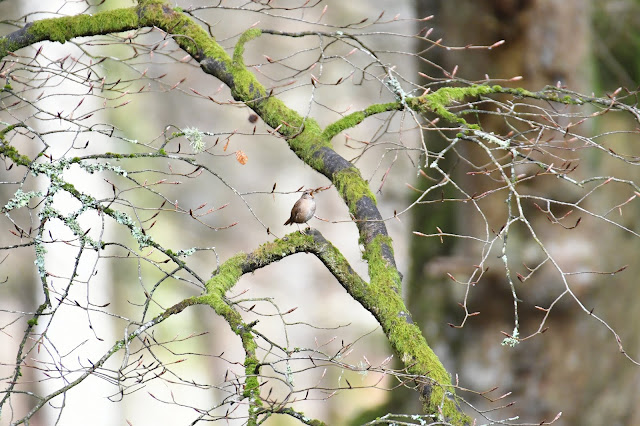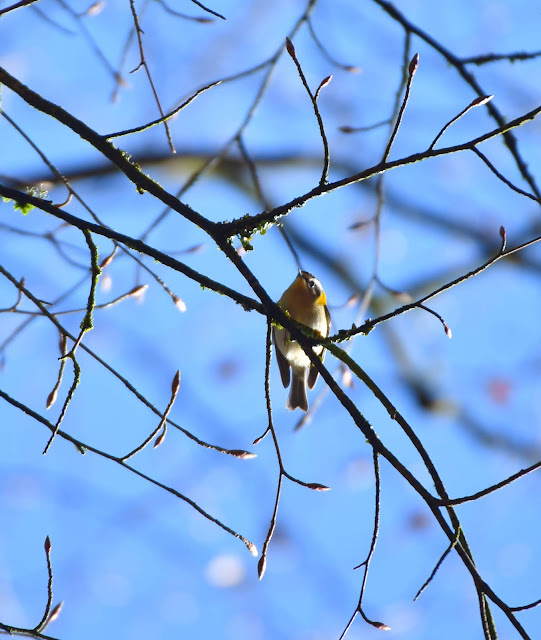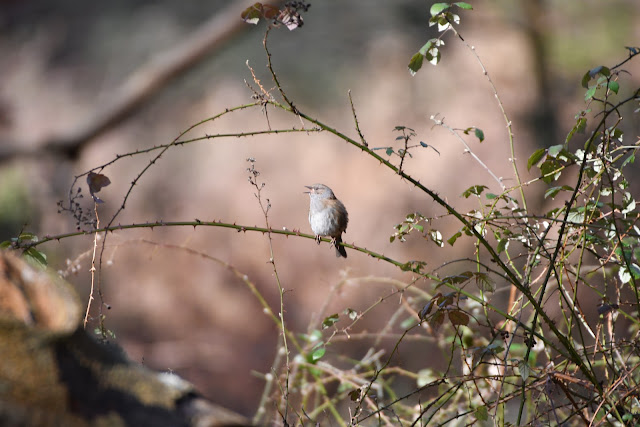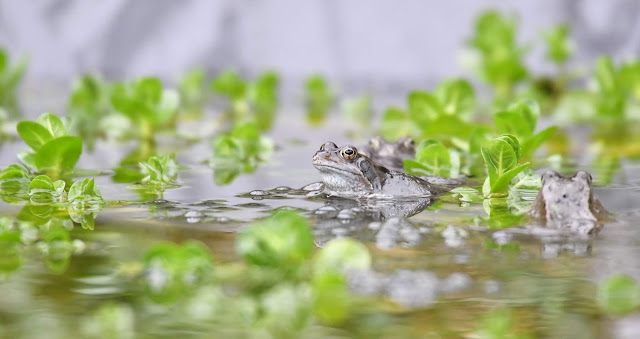6.45 am at Crab Tree Bog. De ja vu was striking as I pulled into the car park.
I had definitely been here before. In fact one week previously looking unsuccessfully for that Great Grey Shrike. Second time lucky perhaps?
There were plenty of Fallow Deer around, most intent on our presence.
And then not so much...
Crab Tree Bog is definitively that, a massive sponge absorbing rainfall and protecting the outlying areas from flooding whilst creating and supporting a rich biodiversity.
My friend Chris and I had met here at dawn to survey the area and most notably try to spot the Shrike or GGS as we affectionally call it.
In amongst the myriad of brooks, streams and ditches we heard a neanderthal call which we thought at first were frogs. They sounded a little different to the ones calling to their mates in my pond, so my secondary deduction were Toads. Eventually after a detailed search, we came across one warty little amphibian. I was hoping for a Natterjack Toad but the lack of yellow stripe down it's spine relegated it to a Common. Still good to see as Toads aren't as prevalent as frogs, certainly not where I live. They were proving a little elusive to photograph however.
Our circular walk here was drawing to a close when we spotted a Lapwing hidden in amongst the damp heathland. Quite possibly setting up territory ready for the arrival of Spring. Once again, still no GGS. After all, it's not a Zoo, this is the unpredictability of nature.
Next destination was Mark Ash Wood some three miles north from our current position. Chris was in need of a sighting of the Lesser Spotted Woodpecker I was fortunate enough to stumble across the previous weekend.
This is a good place to spot them and is a little pocket of woodland that has a great aesthetic to it.
The tiny unmarked car park usually gives up the sights and sounds of Stock Doves calling and displaying in the Beech tops. They didn't disappoint as we got out of the car. Their call is a resonating 'coo coo coo'. A call that resembles the beginning of a Howler Monkey sound we always think. Strange, but if you heard it, you'd know.
Being a predominantly Beech woodland, the Beech mast is a good food source for Chaffinches and the odd Brambling. The odd Brambling is a winter visitor and on our list to see today. I found one bathing in a muddy puddle on the forest floor. It shot up into the treetops a little bedraggled. Not the best of shots but a record shot nonetheless.
There was quite a lot of life in the trees today. Sometimes this place can be quiet to the point of indolence. It does depend on the time of day and also the weather conditions too.
Wrens are common here. Their scolding chatter can warn you of their presence, and yours too. Their song is one of the harbingers of Spring and always a favourite of mine.
The shapes through the trees can change in an instant with the light. The day was partly cloudy with interspersing sunlight, the remnants of autumn still obvious on the forest floor.
Defying our age difference, Chris's hearing is sharper to my tinnitus inhibited one and he picked up the shrill call of a Firecrest in the canopy. Once tuned in however, the concentration can take over and I could hear them with the right conditions. Little wind in the area and standing still which cuts out the noisy rustle of the leaf litter beneath our feet.
One of my favourite little birds, and so is the overlooked Dunnock or Hedge Sparrow - which is a term that is beginning to die out. They have an understated beauty, reminiscent to me of a Gadwall. They also have a love life that can rival any spicy soap opera.
High above in their display grounds, the constant pitiful cry of Buzzards filled the air. More species setting up territories....
The contrasting deep colours of autumn were beginning to fade through the latter stages of winter with spring on the cusp. The golden leaf litter up through to the north facing moss covered beeches with south facing pale bark.
Our travels through the natural world take in some wonders throughout the year but there are always the regular points of focus we seek that draw out our admiration.
One particular static event narrows down to the base of an individual Beech tree in Mark Ash Wood, where a small clump of Narcissi emerge every February and March.
It's real suntrap in that spot facing south. They couldn't have been placed more perfectly if someone had physically planted them there. Maybe they had many moons ago when the tree was just a sapling or perhaps it is all just coincidental ? Either way, we are drawn to it every year, deep in the forest. A sort of pilgrimage if you will...
New Forest Ponies are an iconic symbol of this place. As we walked around there are many munching nonchalantly on the vegetation. Some look splendid in the sunlight.
Firecrests were everpresent. We picked up another pair zipping through the canopy. They move so fast, keeping and eye on them is difficult, especially with natural barriers creating a screen.
I do love Mark Ash Wood. A short walk here often produces a really positive experience.
Next up, about another three miles north - Acres Down is the 'Go-to' place in the Forest for me. If you need a place to encapsulate all that the New Forest is, in one snapshot, it's here. If I did a bioblitz, it would be off the scale. Not just birdlife but the chain that permeates throughout the whole.
The Woodlark I had seen last week, Chris was wanting a piece of the action.
They weren't singing as profusely as then, if at all ,but we managed to locate one through deduction and the occasionally reliable 'Luck'
The individual I had seen last week was singing from above but today they were quiet and feeding on the ground. Their brilliant camouflage making it difficult to spot on the deck. With patience and stealth, we found one.
As per the majority of our bird species, this one is in stupendous decline. Habitat loss being a huge factor amongst others. This area of heathland, dotted with low scrub and bushes being a perfect space for them. Insect life playing a huge part in their survival.
Being at he very top of Acres Down, it goes without saying - you must scan the horizon for Goshawks. Eagle-eyed Chris was first to clap eyes on a distant one.
We've heard stories of Goshawks flying close through the valley here. I've yet to witness that but the two we were fixed on did seem to be gliding closer. I've definitely heard that line before....
Zooming in did help but they did seem to be coming closer. The definitive tail shape and rounded wing pattern were a dead giveaway.
These are hardcore forest predators. They live in the town streets in Germany but our race seem to prefer the secrecy of forests in localised locations such as here. Maybe if they were as common as Buzzards we wouldn't bat an eyelid. Their habits deep out of reach in the depths of the wood give them a place among the untouchables.
The lower path beckoned through the woodland.
Halfway down it I pinpointed a male Crossbill to Chris high in the Fir trees.
Along the woodland rides, Song Thrush fed without a care for our presence. It's always perturbing when birds operate so close to humans without fear.
Our final destination was to be Eyeworth Pond in Fritham.
An old man made pond that once powered a local mill, now serves as a unique nature reserve. It's most famous inhabitants are imported Mandarin Ducks that thrive in this partially wooded enclave.
The male was keeping a close eye on his mate once they broke cover.
These beautiful wildfowl were imported from Asia into selected parts of Europe. The Chinese see them as a symbol of wedded bliss and fidelity, the Koreans see similar along with the symbol of peace and plentiful offspring. In Japan they are seen as much the same. I can see why...
There is a wonderful pub close by plus only a few houses and farm. The locals put out food for the woodland birds which have grown used to human contact. These Marsh Tits were very confiding.
We left just as the sun appeared for the last time before sunset.
Another enjoyable day in this amazing national park.
The title of this post is a line taken from the song 'The Chinese Way' by Level 42
I had definitely been here before. In fact one week previously looking unsuccessfully for that Great Grey Shrike. Second time lucky perhaps?
There were plenty of Fallow Deer around, most intent on our presence.
And then not so much...
Crab Tree Bog is definitively that, a massive sponge absorbing rainfall and protecting the outlying areas from flooding whilst creating and supporting a rich biodiversity.
My friend Chris and I had met here at dawn to survey the area and most notably try to spot the Shrike or GGS as we affectionally call it.
In amongst the myriad of brooks, streams and ditches we heard a neanderthal call which we thought at first were frogs. They sounded a little different to the ones calling to their mates in my pond, so my secondary deduction were Toads. Eventually after a detailed search, we came across one warty little amphibian. I was hoping for a Natterjack Toad but the lack of yellow stripe down it's spine relegated it to a Common. Still good to see as Toads aren't as prevalent as frogs, certainly not where I live. They were proving a little elusive to photograph however.
Our circular walk here was drawing to a close when we spotted a Lapwing hidden in amongst the damp heathland. Quite possibly setting up territory ready for the arrival of Spring. Once again, still no GGS. After all, it's not a Zoo, this is the unpredictability of nature.
Next destination was Mark Ash Wood some three miles north from our current position. Chris was in need of a sighting of the Lesser Spotted Woodpecker I was fortunate enough to stumble across the previous weekend.
This is a good place to spot them and is a little pocket of woodland that has a great aesthetic to it.
The tiny unmarked car park usually gives up the sights and sounds of Stock Doves calling and displaying in the Beech tops. They didn't disappoint as we got out of the car. Their call is a resonating 'coo coo coo'. A call that resembles the beginning of a Howler Monkey sound we always think. Strange, but if you heard it, you'd know.
Being a predominantly Beech woodland, the Beech mast is a good food source for Chaffinches and the odd Brambling. The odd Brambling is a winter visitor and on our list to see today. I found one bathing in a muddy puddle on the forest floor. It shot up into the treetops a little bedraggled. Not the best of shots but a record shot nonetheless.
There was quite a lot of life in the trees today. Sometimes this place can be quiet to the point of indolence. It does depend on the time of day and also the weather conditions too.
Wrens are common here. Their scolding chatter can warn you of their presence, and yours too. Their song is one of the harbingers of Spring and always a favourite of mine.
The shapes through the trees can change in an instant with the light. The day was partly cloudy with interspersing sunlight, the remnants of autumn still obvious on the forest floor.
Defying our age difference, Chris's hearing is sharper to my tinnitus inhibited one and he picked up the shrill call of a Firecrest in the canopy. Once tuned in however, the concentration can take over and I could hear them with the right conditions. Little wind in the area and standing still which cuts out the noisy rustle of the leaf litter beneath our feet.
One of my favourite little birds, and so is the overlooked Dunnock or Hedge Sparrow - which is a term that is beginning to die out. They have an understated beauty, reminiscent to me of a Gadwall. They also have a love life that can rival any spicy soap opera.
High above in their display grounds, the constant pitiful cry of Buzzards filled the air. More species setting up territories....
The contrasting deep colours of autumn were beginning to fade through the latter stages of winter with spring on the cusp. The golden leaf litter up through to the north facing moss covered beeches with south facing pale bark.
Our travels through the natural world take in some wonders throughout the year but there are always the regular points of focus we seek that draw out our admiration.
One particular static event narrows down to the base of an individual Beech tree in Mark Ash Wood, where a small clump of Narcissi emerge every February and March.
It's real suntrap in that spot facing south. They couldn't have been placed more perfectly if someone had physically planted them there. Maybe they had many moons ago when the tree was just a sapling or perhaps it is all just coincidental ? Either way, we are drawn to it every year, deep in the forest. A sort of pilgrimage if you will...
New Forest Ponies are an iconic symbol of this place. As we walked around there are many munching nonchalantly on the vegetation. Some look splendid in the sunlight.
Firecrests were everpresent. We picked up another pair zipping through the canopy. They move so fast, keeping and eye on them is difficult, especially with natural barriers creating a screen.
I do love Mark Ash Wood. A short walk here often produces a really positive experience.
Next up, about another three miles north - Acres Down is the 'Go-to' place in the Forest for me. If you need a place to encapsulate all that the New Forest is, in one snapshot, it's here. If I did a bioblitz, it would be off the scale. Not just birdlife but the chain that permeates throughout the whole.
The Woodlark I had seen last week, Chris was wanting a piece of the action.
They weren't singing as profusely as then, if at all ,but we managed to locate one through deduction and the occasionally reliable 'Luck'
The individual I had seen last week was singing from above but today they were quiet and feeding on the ground. Their brilliant camouflage making it difficult to spot on the deck. With patience and stealth, we found one.
As per the majority of our bird species, this one is in stupendous decline. Habitat loss being a huge factor amongst others. This area of heathland, dotted with low scrub and bushes being a perfect space for them. Insect life playing a huge part in their survival.
Being at he very top of Acres Down, it goes without saying - you must scan the horizon for Goshawks. Eagle-eyed Chris was first to clap eyes on a distant one.
We've heard stories of Goshawks flying close through the valley here. I've yet to witness that but the two we were fixed on did seem to be gliding closer. I've definitely heard that line before....
Zooming in did help but they did seem to be coming closer. The definitive tail shape and rounded wing pattern were a dead giveaway.
These are hardcore forest predators. They live in the town streets in Germany but our race seem to prefer the secrecy of forests in localised locations such as here. Maybe if they were as common as Buzzards we wouldn't bat an eyelid. Their habits deep out of reach in the depths of the wood give them a place among the untouchables.
The lower path beckoned through the woodland.
Halfway down it I pinpointed a male Crossbill to Chris high in the Fir trees.
Along the woodland rides, Song Thrush fed without a care for our presence. It's always perturbing when birds operate so close to humans without fear.
Our final destination was to be Eyeworth Pond in Fritham.
An old man made pond that once powered a local mill, now serves as a unique nature reserve. It's most famous inhabitants are imported Mandarin Ducks that thrive in this partially wooded enclave.
The male was keeping a close eye on his mate once they broke cover.
These beautiful wildfowl were imported from Asia into selected parts of Europe. The Chinese see them as a symbol of wedded bliss and fidelity, the Koreans see similar along with the symbol of peace and plentiful offspring. In Japan they are seen as much the same. I can see why...
There is a wonderful pub close by plus only a few houses and farm. The locals put out food for the woodland birds which have grown used to human contact. These Marsh Tits were very confiding.
We left just as the sun appeared for the last time before sunset.
Another enjoyable day in this amazing national park.
The title of this post is a line taken from the song 'The Chinese Way' by Level 42


























































































